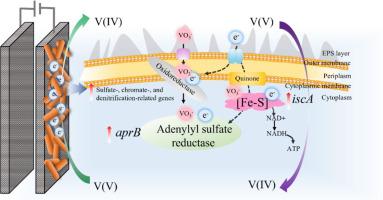地下水中无外源电子供体补充的反硝化硫杆菌生物电化学还原钒酸盐的新代谢途径
IF 12.4
1区 环境科学与生态学
Q1 ENGINEERING, ENVIRONMENTAL
引用次数: 0
摘要
微生物介导的钒酸盐[V(V)]还原被广泛接受为修复V污染地下水的可持续方法。然而,这一过程依赖于外源电子供体,难以精确控制并注入含水层。在这项研究中,证明了自养反硝化硫杆菌在没有外源性电子供体补充的情况下,生物电化学还原V(V)。当外加电压为0.9 V时,在14 d内去除了94.5±0.95%的V(V), V(V)主要在阴极被生物还原。不溶性四价V是主要的还原产物,细胞内外均有分布。电化学分析、转录组学、RT-qPCR和物质定量分析共同提示细胞外V(V)还原是由细胞色素c和细胞外聚合物介导的。细胞内V(V)的还原由硫酸盐、铬酸盐和反硝化相关的还原酶催化,并通过呼吸链中的NADH、Fe-S簇和醌等氧化还原组分实现。特别是功能基因aprB和iscA的新的V(V)还原途径,通过异种表达和蛋白催化实验进一步证实。本研究为地下水中V(V)的生物修复提供了创新策略,并对V(V)生物还原的分子机制有了新的认识。本文章由计算机程序翻译,如有差异,请以英文原文为准。


Novel metabolic pathways of bioelectrochemical vanadate reduction by Thiobacillus denitrificans without exogenous electron donor supplementation in groundwater
Microbially mediated vanadate [V(V)] reduction is well accepted as a sustainable approach for remediating V-polluted groundwater. However, this process relies on exogenous electron donors, which is challenging to control precisely and inject into aquifer. In this study, bioelectrochemical V(V) reduction by autotrophic Thiobacillus denitrificans was demonstrated without exogenous electron donor supplementation. At an applied voltage of 0.9 V, 94.5 ± 0.95 % of V(V) was removed within 14 d V(V) was mainly bioreduced at the cathode. Insoluble tetravalent V was the main reduction product, distributed both outside and inside of cells. Electrochemical analysis, transcriptomics, RT-qPCR and substance quantification analysis collectively suggested that extracellular V(V) reduction was mediated by cytochrome c and extracellular polymeric substances. Intracellular V(V) reduction was catalyzed by sulfate-, chromate-, and denitrification-related reductases and achieved by redox components including NADH, Fe-S clusters, and quinones in respiratory chain. Particularly, the newly V(V) reduction pathways of the functional genes aprB and iscA were further confirmed via in vitro trials involving heterologous expression and protein catalysis assays. This study provided an innovative strategy for V(V) bioremediation in groundwater and gained novel insight into molecular mechanisms of V(V) bioreduction.
求助全文
通过发布文献求助,成功后即可免费获取论文全文。
去求助
来源期刊

Water Research
环境科学-工程:环境
CiteScore
20.80
自引率
9.40%
发文量
1307
审稿时长
38 days
期刊介绍:
Water Research, along with its open access companion journal Water Research X, serves as a platform for publishing original research papers covering various aspects of the science and technology related to the anthropogenic water cycle, water quality, and its management worldwide. The audience targeted by the journal comprises biologists, chemical engineers, chemists, civil engineers, environmental engineers, limnologists, and microbiologists. The scope of the journal include:
•Treatment processes for water and wastewaters (municipal, agricultural, industrial, and on-site treatment), including resource recovery and residuals management;
•Urban hydrology including sewer systems, stormwater management, and green infrastructure;
•Drinking water treatment and distribution;
•Potable and non-potable water reuse;
•Sanitation, public health, and risk assessment;
•Anaerobic digestion, solid and hazardous waste management, including source characterization and the effects and control of leachates and gaseous emissions;
•Contaminants (chemical, microbial, anthropogenic particles such as nanoparticles or microplastics) and related water quality sensing, monitoring, fate, and assessment;
•Anthropogenic impacts on inland, tidal, coastal and urban waters, focusing on surface and ground waters, and point and non-point sources of pollution;
•Environmental restoration, linked to surface water, groundwater and groundwater remediation;
•Analysis of the interfaces between sediments and water, and between water and atmosphere, focusing specifically on anthropogenic impacts;
•Mathematical modelling, systems analysis, machine learning, and beneficial use of big data related to the anthropogenic water cycle;
•Socio-economic, policy, and regulations studies.
 求助内容:
求助内容: 应助结果提醒方式:
应助结果提醒方式:


